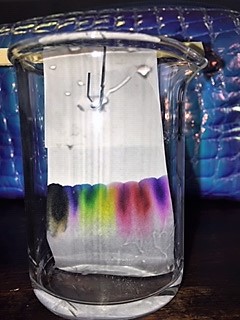Chromatography
Chromatography is a laboratory technique for the separation of a mixture. The mixture is dissolved in a fluid called the mobile phase, which carries it through a structure holding another material called the stationary phase. The various constituents of the mixture travel at different speeds, causing them to separate. The separation is based on differential partitioning between the mobile and stationary phases. Subtle differences in a compound's partition coefficient result in differential retention on the stationary phase and thus affect the separation.
Chromatography may be preparative or analytical. The purpose of preparative chromatography is to separate the components of a mixture for more advanced use (and is thus a form of purification). Analytical chromatography is done normally with smaller amounts of material and is for establishing the presence or measuring the relative proportions of analytes in a mixture.
Types of Chromatography[edit | edit source]
Chromatography techniques can be classified by the mechanism of separation. The most common types include:
- Gas Chromatography (GC) - where the mobile phase is a gas and the stationary phase is a liquid or solid.
- High-Performance Liquid Chromatography (HPLC) - uses high pressure to push a liquid mobile phase through a stationary phase.
- Thin Layer Chromatography (TLC) - where the stationary phase is a thin layer of adsorbent material on a glass, metal, or plastic plate.
- Paper Chromatography - uses paper as the stationary phase.
- Ion Exchange Chromatography - separates ions and polar molecules based on their affinity to the ion exchanger.
- Size Exclusion Chromatography (SEC) - also known as gel filtration chromatography, separates molecules based on their size.
- Affinity Chromatography - is based on selective non-covalent interaction between an analyte and specific molecules. It is often used in biochemistry in the purification of proteins bound to tags.
Applications[edit | edit source]
Chromatography is used in both qualitative and quantitative analysis of both organic and inorganic samples. It has a wide range of applications:
- In the pharmaceutical industry, chromatography is used to prepare large quantities of extremely pure materials.
- In environmental monitoring, it is used to detect pollutants in air and water.
- Chromatography techniques are essential in the field of biochemistry for separating and analyzing complex protein mixtures.
- In the food industry, it is used for analyzing food products for quality control and to ensure compliance with food safety standards.
- Forensic science utilizes chromatography for analyzing drugs, blood samples, and fibers.
Chromatography Theory[edit | edit source]
The theory of chromatography revolves around the concept of separation. Separation occurs due to the different speeds at which the components of a mixture move through the stationary phase, depending on their interactions with the mobile and stationary phases. The efficiency of a chromatographic separation is measured by the resolution between two peaks in a chromatogram, which depends on the column length, the nature of the stationary phase, the temperature, and the flow rate of the mobile phase.
See Also[edit | edit source]
Navigation: Wellness - Encyclopedia - Health topics - Disease Index - Drugs - World Directory - Gray's Anatomy - Keto diet - Recipes
Search WikiMD
Ad.Tired of being Overweight? Try W8MD's physician weight loss program.
Semaglutide (Ozempic / Wegovy and Tirzepatide (Mounjaro) available.
Advertise on WikiMD
WikiMD is not a substitute for professional medical advice. See full disclaimer.
Credits:Most images are courtesy of Wikimedia commons, and templates Wikipedia, licensed under CC BY SA or similar.
Contributors: Prab R. Tumpati, MD





